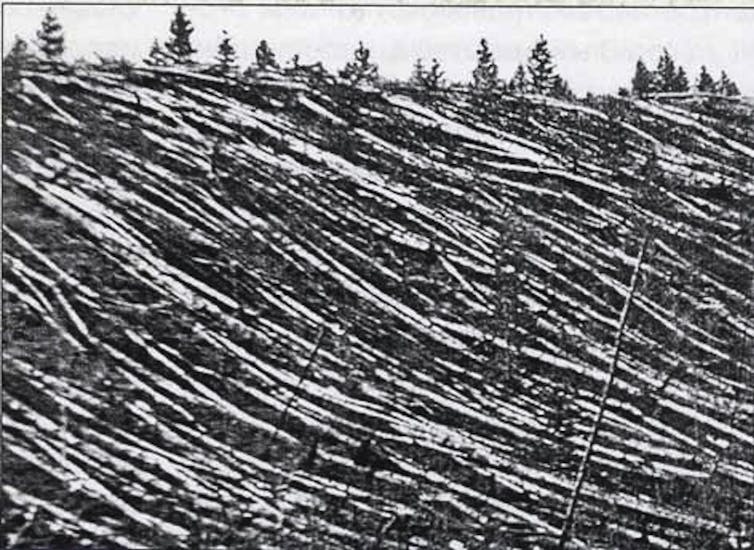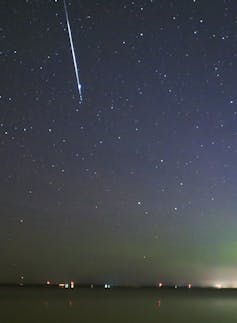With the Taurid meteor bathe now hitting the evening skies worldwide, search for what could possibly be a celestial deal with – you would possibly see capturing stars, and possibly even fireballs, the largest and brightest meteors.
As the complete moon begins to wane after Nov. 15, the sky might be darker, as a consequence of diminishing moonlight, so discovering the meteors will get simpler. That stated, the very best visibility for the meteors by the remainder of the month will come simply earlier than moonrise every evening.
Past the sunshine present, there’s something else that scientists in addition to onlookers have lengthy questioned about: the chance that greater chunks are within the Taurid meteor streams, chunks the dimensions of boulders, buildings and even mountains.
And if that’s true, might a kind of monster-sized Taurid objects collide with Earth? May they wipe out a metropolis, or worse? Is it potential that’s already occurred, someday in our planet’s previous?
This animation simulates the movement of the hypothetical Taurid meteor swarm by house.
As a physicist who researches the danger that comets and asteroids pose to the Earth, I’m conscious that it is a topic the place pseudoscience typically competes with precise science. So let’s attempt to discover the road between reality and fiction.
Pig Pen, glowing tails and capturing stars
Comet Encke is the so-called father or mother comet of the Taurid meteors. It’s comparatively small, simply over 3 miles (virtually 5 kilometers) in diameter, and crosses inside Earth’s orbit and again out each 3.3 years.
As Encke strikes, it sheds mud wherever it goes, just like the Peanuts character Pig Pen. A meteor bathe happens when that mud and particles mild up whereas getting into Earth’s environment at excessive speeds. In the end, they vanish into an incandescent puff of vapor with a glowing tail, creating the phantasm of a “shooting star.”
However mud isn’t all that breaks off the comet. So do greater chunks, the dimensions of pebbles and stones. After they collide with the air, they create the a lot brighter fireballs, which typically explode.
A picture of comet Encke, taken by NASA’s MESSENGER spacecraft in November 2013.
NASA/Johns Hopkins College Utilized Physics Laboratory/Carnegie Establishment of Washington/Southwest Analysis Institute
Doomsday showers
The “coherent catastrophism” speculation means that comet Encke was created when a good bigger comet broke up into items; Encke survived as the biggest piece. The speculation additionally means that different mountain-sized chunks broke off and coalesced into a big swarm of fragments too. If such a swarm exists, there’s a risk that these massive chunks might someday hit Earth because it passes by the swarm.
However simply because one thing is likely to be bodily potential doesn’t imply that it exists. Mainstream astronomers have rejected this idea’s most catastrophic predictions. Amongst different causes, scientists have by no means noticed excessive concentrations of those mountain-sized objects.
Regardless of the dearth of proof, researchers on the fringes of science have embraced the thought. They declare the Earth skilled a world catastrophic swarm 12,900 years in the past; the affect, they are saying, prompted continent-wide firestorms, floods and abrupt local weather change that led to the mass extinction of huge mammals, corresponding to woolly mammoths, and the disappearance of early People often called the Clovis folks.
The proof for a catastrophic trigger of those occasions, most of which didn’t occur, is missing. Nonetheless, the thought has gained a big following and shaped the premise for British writer Graham Hancock’s widespread TV sequence, “Ancient Apocalypse.”

This photograph exhibits the flattened bushes ensuing from the Tunguska occasion.
Common Historical past Archives/Common Photos Group through Getty Photos
The Tunguska occasion
However even outlandish concepts can have components of fact, and there are hints that some objects – extra than simply mud and particles, however lower than doomsday measurement – certainly exist within the Taurid meteor stream, and that the Earth has already encountered them.
One clue comes from an occasion on June 30, 1908, when an unlimited explosion within the sky blew down hundreds of thousands of bushes in Siberia. This was the Tunguska occasion – an airburst from an object that will have been as much as 160 ft (about 50 meters) in diameter.
The collision unleashed a number of megatons of power, which is roughly the equal of a giant thermonuclear bomb. What occurs is that this: The incoming object penetrates deep into Earth’s environment, and the dense air slows it down and heats it up till it vaporizes and explodes.
May this object have been a Taurid? In spite of everything, the Taurids cross Earth’s orbit twice a yr – not simply in autumn, but additionally in June.

In a 2015 photograph, a glowing Taurid fireball descends over Lake Simcoe in Ontario, Canada.
Orchidpost/iStock through Getty Photos Plus
Right here’s the proof: First, the descriptions of the trajectory of the Tunguska airburst, as reported by eyewitness observers, is in line with that of an object coming from the Taurid stream.
What’s extra, the sample of blast harm on the bottom beneath an airburst depends upon the trajectory of the exploding object. Supercomputer simulations present that the form of the floor blast that will be brought on by an exploding Taurid object matches the sample of fallen bushes at Tunguska.
Lastly, through the Taurid meteor bathe in 1975, folks noticed massive fireballs – and seismometers, beforehand positioned on the Moon by Apollo astronauts, detected seismic occasions on the lunar floor. Scientists interpreted these occasions as impacts, presumably made by the Taurid meteors.
In 2032 and 2036, the Taurid swarm – assuming it exists – is predicted to be nearer to the Earth than any time since 1975. That may imply the Moon, and maybe the Earth, could possibly be pelted once more in these years.
There’s time to determine this out. Scientists can increase their astronomical surveys to search for Tunguska-sized objects on the places the place they’re predicted to be the subsequent time they’re in our neighborhood.
Most scientists stay skeptical that such a swarm exists, but it surely’s the job of planetary defenders to research potential threats, even when the danger is small. In spite of everything, a Tunguska-sized object might conceivably demolish a significant metropolis and kill hundreds of thousands; an correct rely of objects on a possible collision course is crucial.
Put doomsday situations and historic apocalypses apart. The actual query, and nonetheless an open one, is whether or not a Taurid swarm might ship extra Tunguska-sized objects than would in any other case be anticipated. This may imply we have now underestimated the danger from future airbursts.